
The Regional Municipality of York, also called York Region, is a regional municipality in Southern Ontario, Canada, between Lake Simcoe and Toronto. The region was established after the passing of then Bill 102, An Act to Establish The Regional Municipality of York, in 1970. It replaced the former York County in 1971, and is part of the Greater Toronto Area and the inner ring of the Golden Horseshoe. The regional government is headquartered in Newmarket.

Yonge Street is a major arterial route in the Canadian province of Ontario connecting the shores of Lake Ontario in Toronto to Lake Simcoe, a gateway to the Upper Great Lakes.

Finch Avenue is an arterial thoroughfare that travels east–west in Toronto, Ontario, Canada. The road continues west into the Regional Municipality of Peel as Regional Road 2 and east into the Regional Municipality of Durham as Regional Road 37.
York Region Transit (YRT) is the public transit operator in York Region, Ontario, Canada. Its headquarters are in Richmond Hill, at 50 High Tech Road.

The Toronto Street Railway (TSR) was the operator of a horse-drawn streetcar system from 1861 to 1891 in Toronto, Ontario, Canada. Its successor, the Toronto Railway Company, inherited the horsecar system and electrified it between 1892 and 1894.
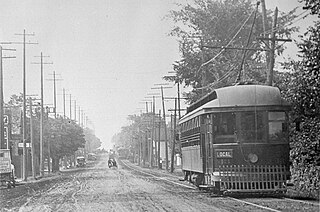
The Metropolitan Street Railway was the operator of the Metropolitan line in the Toronto area that started out as a local horsecar line and transformed itself into an electric radial line extending to Lake Simcoe, following an old stage coach route. In 1904, the railway was acquired by the Toronto and York Radial Railway (T&YRR) and became the T&YRR Metropolitan Division. In 1922, the City of Toronto acquired the T&YRR and contracted Ontario Hydro to manage the four T&YRR lines including the Metropolitan. In 1927, the TTC took over the operation of the Metropolitan Line to Sutton, and renamed it the Lake Simcoe line. In 1930, the TTC closed the Metropolitan Line but shortly reopened the portion between Glen Echo and Richmond Hill operating it as the North Yonge Railways until 1948.

The North Yonge Railways was a radial railway line operated by the Toronto Transportation Commission from 1930 to 1948 between Glen Echo (Toronto) and Richmond Hill. The line was created by reopening the southern portion of the TTC's Lake Simcoe radial line that had closed in 1930.
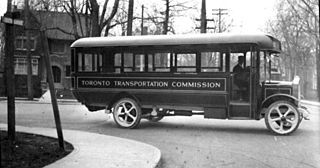
Toronto Transportation Commission (TTC) was the public transit operator in Toronto, Ontario, Canada, beginning in 1921. It operated buses, streetcars and the island ferries. The system was renamed the Toronto Transit Commission (TTC) in 1954.
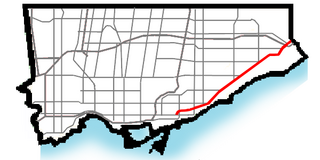
Kingston Road is a major arterial road in Toronto and Durham Region, Ontario. It the southernmost major (mainly) east-west road in the eastern portion of Toronto, specifically in the district of Scarborough, and runs east to Ajax in Durham. Until 1998, it formed a portion of Highway 2. The name of the street is derived from Kingston, Ontario as the road was the primary route used to travel from Toronto to the settlements east of it situated along the shores of Lake Ontario; in the west end of Kingston, the road was referred to as the York Road until at least 1908, and is today named Princess Street.

Gray Coach was a Canadian inter-city bus line based in Toronto, Ontario, from 1927 to 1992. It was founded and initially owned by the Toronto Transportation Commission, until sold to Stagecoach in 1990. In 1992 the business was sold to Greyhound Canada and the brand was retired.
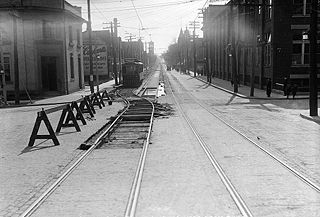
The history of public transportation in Toronto in Canada dates back to the middle 19th century under many different private companies, organizations and owners, which were all later unified as a single government-run entity during the 1920s.

Markham Transit was a public transit system for the town of Markham, Ontario, Canada. It was created in 1973 and operated by Travelways and Miller Transit Limited after 1984 on behalf of the then Town of Markham. The service was merged into York Region Transit in 2001 with Miller Transit continuing to operate most Markham routes.

Richmond Hill Transit was created in 1960 to provide public transit service in Richmond Hill, Ontario, Canada. It was initially operated by Trailways of Canada Limited, then Travelways starting in 1976 and Laidlaw in the 1980s. Services merged with the Markham, Newmarket and Vaughan transit systems to form York Region Transit in 2001.
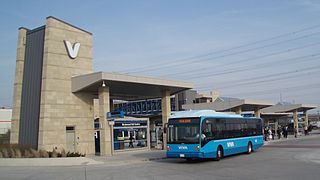
Viva is the bus rapid transit operations of York Region Transit in York Region, Ontario, Canada. Viva service forms the spine for YRT's local bus service, providing seamless transit service across York Region with connections to northern Toronto.
Transportation in the Canadian city of Toronto forms the hub of the road, rail and air networks in the Greater Toronto Area and much of southern Ontario. There are many forms of transport in the city, including railways, highways, and public transit. Toronto also has an extensive network of bicycle lanes and multi-use trails and paths.
MoveOntario 2020 was a 2007 plan proposed by the Government of Ontario that would fund 52 rapid-transit projects throughout the Greater Toronto and Hamilton Area in Ontario, Canada. It was succeeded by The Big Move and GO Transit's Go 2020.
The city of Markham in Ontario, Canada, offers a complex transportation infrastructure. These include airports, highways, public transit, regional roads, municipality-funded roads, and train services.
The history of Richmond Hill began when the First Nations came and settled in the area. With the Toronto Purchase, the city gradually expanded with new greenhouse industries and improved transportation infrastructure.
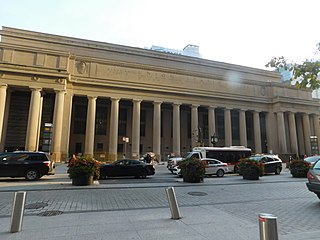
Public transportation in the Canadian city of Toronto dates back to 1849 with the creation of a horse-drawn stagecoach company. Today, Toronto's mass transit is primarily made up of a system of subways, buses, and streetcars, covering approximately 1,200 km (750 mi) of routes operated by the Toronto Transit Commission (TTC) and inter-regional commuter rail and bus service provided by GO Transit.

Toronto-gauge railways are tram and rapid transit lines built to Toronto gauge, a broad gauge of 4 ft 10+7⁄8 in. This is 2+3⁄8 in (60 mm) wider than standard gauge of 4 ft 8+1⁄2 in which is by far the most common track gauge in Canada. The gauge is unique to the Greater Toronto Area and is currently used on the Toronto streetcar system and the Toronto subway, both operated by the Toronto Transit Commission. As well, the Halton County Radial Railway, a transport museum, uses the Toronto gauge so its rail line can accommodate its collection of Toronto streetcars and subway trains. Several now-defunct interurban rail systems also once used this gauge.


















